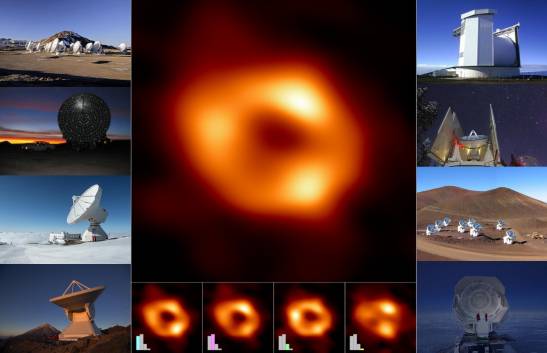Didn’t we already know about the black hole at the center of our galaxy?
Previous studies, including those that in 2020 won Reinhard Genzel and Andrea Ghez the Nobel Prize in Physics, had already shown that at the center of the Milky Way there is a supermassive object – called Sagittarius A* or Sgr A*– with a mass four million times that of the Sun. They deduced this from the motion of the stars revolving around it.
What is now presented for the first time is its image, a direct visual evidence. Although the hole itself is not actually visible, its massive gravity swallows up all light, but its dark shadow is surrounded by a ring of hot, glowing gas. The shadow is about 52 microarcseconds in diameter, which is equivalent to seeing a CD on Earth’s Moon, taking into account the distance from the hole: about 27,000 light years.
As the size of the shadow is proportional to the mass, it is confirmed that it has about four million solar massesresult that is in perfect agreement with Einstein’s theory of general relativity.
What differences are there between the image of Sagittarius A* and that of M87* presented in 2019?
apparently both the images are similar, despite being two very different holes. The one in our galaxy is more than a thousand times smaller, but it is closer and is also less massive: Sagittarius A* has 4.3 million solar masses compared to 6.6 billion for M87*, which is much further away, 55,000 .000 light years away. Their orientations towards us are also different.
However, the similarity of the two images confirms a fundamental aspect of the general relativity, as it predicts that all black holes behave and look the same, regardless of their mass. This implies that the entire universe is full of these luminous ‘donuts’.
In addition, the two rotating holes are also ‘fed’ at a different rate. The gas takes between days and weeks to orbit around M87* –the big one–, but in Sgr A* –the little one– completes a orbit in just a few minutes. This makes observations difficult, as the brightness and pattern of the gas swirling around our galaxy’s hole changes rapidly.
While the M87* was an easier, more stable lens where almost all of your images looked the same, this was not the case with the Sagittarius A*. The featured image is a average of several which captured the international collaboration of the Event Horizon Telescope (EHT by their abbreviations in English).
How was the image obtained?
Inside 2017 the EHT used a network of eight radio telescopes distributed around the world (ALMA and APEX in Chile, IRAM in Spain, LMT in Mexico, JCMT, SMT and SMA in the United States and SPT in the South Pole) that work as a virtual Earth-sized. To create it and combine all the signals, a technique called very long-base interferometry (VLBIwhere instead of lenses mathematical operations are used).
But, although it has a planetary scale, this global telescope is made up of a limited number of antennas, and reconstructing a ‘photograph’ with all its data is equivalent to guessing a sentence knowing only a few of its letters. To solve it and provide the final average image, powerful algorithms and computers.
From Spain, three institutions made a fundamental contribution: the Instituto de Astrofísica de Andalusia (IAA-CSIC), the University of Valencia (UV) and the Millimetric Radio Astronomy Institute (IRAM), with its powerful 30-meter antenna on Pico Veleta (Granada).
What challenges lie ahead?
One of the most important is to present not an image of Sagittarius A*, but a ‘film’ of the gas orbiting the black hole. In fact, this is what was announced three years ago when the image of the M87* was presented, but at the moment there is not enough information. The recent addition of more radio telescopes to the EHT network (GLT in Greenland and NOEMA in France), as well as updates to existing ones and new observation campaigns – the last one in March this year – will help to achieve this goal.
In addition, the EHT scientific collaboration will attempt to reconstruct the magnetic field of this and other supermassive black holes, as it is an essential factor in the physics and formation of the relativistic jets associated with this type of object.
Information provided by researchers Antxon Alberdi, Rocco Lico, Ilje Cho, Guang-Yao Zhao, Antonio Fuentes and Thalia Traianou from the Institute of Astrophysics of Andalusia (IAA-CSIC), Ivan Martí Vidal from the University of Valencia and Miguel Sanches Portal of the Instituto de Radioastronomia Milimeter (IRAM) during the press conference held on May 12, 2022 at the CSIC headquarters in Madrid. It was also linked to the one organized in Munich (Germany), in which the following participated: Xavier BarconsDirector-General of the European Southern Observatory (ESO); Huib Jan van LangeveldeEHT project manager; Sarah Issau from the Harvard & Smithsonian Center for Astrophysics (USA), Thomas p. Krichbaum from the Max Planck Institute for Radio Astronomy (Germany) and Jose Luis Gomes of the IAA-CSIC.
